Innovative Bathroom Painting Designs for Modern Spaces
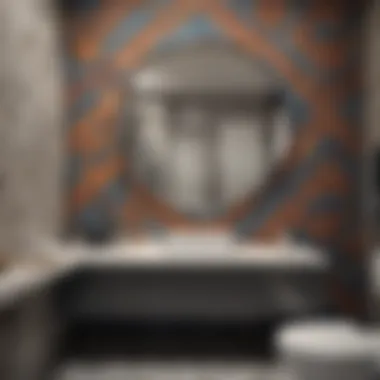
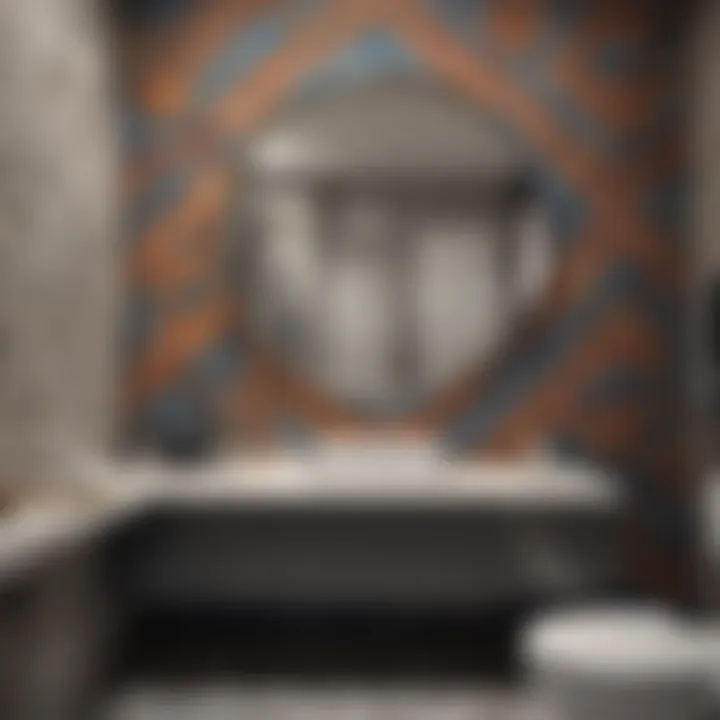
Intro
In the realm of home improvement, the bathroom often receives less attention compared to other rooms. Yet, it stands as a vital part of daily life, serving both functional and aesthetic purposes. Innovative painting designs can transform this space into a sanctuary of relaxation and style. This article explores how color, technique, and design trends can elevate the bathroom experience.
Design Inspirations
The bathroom should reflect personal taste while being functional. Numerous design inspirations exist, enabling homeowners to express individuality. Below, we delve into contemporary trends and color choices that can redefine this space.
Latest Trends in Bath and Bedroom Design
Current trends in bathroom design focus on simplicity and elegance. Popular designs include:
- Minimalism: Utilizing clean lines and uncluttered surfaces helps bring a serene ambiance. Opt for neutral shades or monochromatic palettes.
- Nature-inspired Themes: Earthy tones and organic designs create a calming atmosphere. Consider using shades akin to forest greens and sandy beiges.
- Vintage Revival: Classic styles with modern twists return to favor. Think of ornate fixtures paired with soft pastel colors.
These trends not only add visual appeal but also create a sense of harmony. Keeping updated with design showcases and photography on platforms like Pinterest can provide valuable inspiration.
Color Palettes and Themes
Choosing the right color palette is crucial. The colors in a bathroom can influence mood and perception of space. Some effective choices include:
- Cool Whites: Bright whites can make small bathrooms feel larger. Adding textures, such as glossy finishes or tile patterns can enhance depth.
- Soft Blues and Greens: Gentle hues evoke a tranquil environment, reminiscent of nature. These palettes work well in conjunction with natural light, enhancing a spacious feel.
- Bold Accents: For those who prefer vibrancy, strategic use of bold colors like deep navy or rich burgundy can create stunning focal points.
When selecting colors, consider the overall theme and how it interacts with other elements in the bathroom, including fixtures and flooring.
"Color is the keyboard, the eyes are the harmonies, the soul is the piano with many strings." — Wassily Kandinsky
Engaging with these color themes can rejuvenate a space, leading to a favorable atmosphere.
Functional Elements
Functionality in bathroom design cannot be overlooked. Paint choices and room layout contribute greatly to practicality. Let’s explore ways to enhance functionality.
Space Optimization Tips
Maximizing space is a necessity, especially in smaller bathrooms. Strategies include:
- Vertical Space Utilization: Consider painting a single feature wall or going for lighter colors on walls to draw the eyes upward, creating a sense of height.
- Mirrors: Incorporate mirrors with decorative frames. They reflect both light and space, enhancing the overall aesthetic.
- Smart Storage Solutions: Choose built-in shelving or cabinets. Painting these elements in harmonious shades unifies the look.
Multi-Functional Furniture Choices
In a modern bathroom, furniture should serve multiple purposes. Consider:
- Storage Benches: These provide seating as well as hidden compartments for towels and toiletries.
- Built-in Vanities: A well-designed vanity can offer both storage and counter space, crucial for daily routines.
- Foldable Fixtures: Options like drop-leaf tables can add flexibility, especially in compact areas.
Implementing these functional elements ensures that the bathroom remains practical while still being stylish.
Incorporating innovative bathroom painting designs involves more than just aesthetic changes. It requires an understanding of both visual appeal and functionality. Thoughtful selection of colors along with practical design elements can make a substantial impact. This article aims to provide insights that will inspire and support readers in their efforts to transform their bathrooms.
Overview of Bathroom Painting Designs
Bathroom painting designs serve as a pivotal element in transforming the overall atmosphere of a space. The choices made in color and technique not only impact the visual appeal but also enhance the functionality of the bathroom. This overview will dive into essential components in selecting and utilizing bathroom painting designs, underscoring the significance of these aesthetic decisions and practical considerations.
Importance of Aesthetic Choices
Aesthetic choices in a bathroom context stretch beyond mere decoration. They impart a sense of style and reflect the personality of the homeowner. By employing different colors, patterns, and textures, individuals can create a calming spa-like ambiance or a vibrant, lively environment, depending on their preferences. It is crucial to remember that colors invoke emotions; for instance, soft blues and greens often evoke feelings of tranquility, while brighter shades stimulate energy. Incorporating these factors into design choices allows for a more intentional creation of space.
Moreover, an aesthetically pleasing bathroom can enhance the property's value. Potential buyers may be more inclined to favor homes that exude a sense of style, which can lead to higher selling prices. Therefore, investing time in thoughtful painting designs can pay dividends in the long run.
Functional Considerations
While aesthetics demand attention, functionality is equally important. Bathrooms, being moisture-prone areas, require careful consideration of paint types that stand up to humidity and wear. In this regard, the use of moisture-resistant paints is essential to safeguard against mildew and peeling.
Additionally, techniques and finishes should not be overlooked. Glossy finishes can be easier to clean, making them a practical choice for families or frequent users. Balancing the beauty with the practicality of materials ensures that the space remains durable and user-friendly.
To summarize, the importance of examining both aesthetic choices and functional considerations in bathroom painting cannot be overstated. It allows for the creation of a space that is not only visually appealing but also well-equipped to endure the demands of everyday use.
"The right color choice can elevate not only the space itself but also the overall quality of life within the home."
By exploring innovative painting techniques while keeping functionality in mind, homeowners can achieve a harmonious blend of beauty and resilience in their bathroom design.
Current Trends in Bathroom Design
The landscape of bathroom design is rapidly evolving, reflecting both changing aesthetics and shifting functionality. Understanding current trends allows homeowners to create spaces that are not only visually appealing but also practical. Keeping up with these trends can help individuals maximize their bathroom’s potential, supporting both personal style and daily utility.
Minimalist Approaches
Minimalism has become a guiding principle in contemporary bathroom design. This approach emphasizes simplicity and functionality. By stripping away excess, a tranquil environment is cultivated. Key benefits of minimalist design include easier maintenance and the ability to create a sense of spaciousness in smaller bathrooms.
Homeowners opting for minimalism should consider the following elements:
- Color palette: Neutral colors like whites, beiges, and soft grays help foster a serene atmosphere.
- Furnishings: Select streamlined fixtures and cabinetry that prioritize function but maintain elegance.
- Decor: Limit decor to essential pieces, perhaps a single piece of art or a few plants, to keep visual clutter at bay.
This style suits those seeking peace in their personal spaces, while also enabling them to age gracefully over time.
Bold Color Choices
Conversely, bold colors are making a strong statement in bathroom design. Vibrant hues create excitement and energy, transforming mundane spaces into lively retreats. Homeowners can utilize striking tones to add character and express personality. Common bold choices include deep blues, rich greens, and vivid reds.
When integrating bold colors, here are a few aspects to consider:
- Accent walls: One wall in a vibrant shade can provide a focal point without overwhelming the room.
- Complementary elements: Pair bold colors with neutral tones to balance intensity and create harmony.
- Fixtures: Incorporate colored fixtures or accessories to enhance the overall theme.
For many, this trend reflects freedom of expression in their homes. It allows individuals to convey their uniqueness through design.
Textured Finishes
Textured finishes are increasingly popular in painting designs, adding depth and dimension to spaces. This approach goes beyond flat paint, allowing for creativity and uniqueness. These finishes can range from matte to glossy, providing varied experiences of light reflection and touch.
Several techniques for textured finishes include:
- Stucco: Great for a rustic feel, stucco provides a durable surface.
- Ombre: This trending technique blends colors seamlessly for a soft gradient.
- Metallics: Incorporating metallic paints can create a luxurious touch, reflecting light beautifully.
To successfully implement textured finishes, it is crucial to assess the bathroom's lighting and size. A highly textured surface can work wonders in a well-lit, spacious area but may overpower a small, poorly lit bathroom.
The incorporation of texture allows you to set a specific mood, inviting either calm or intrigue, depending on the design goals.
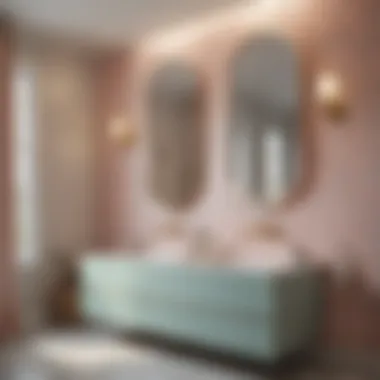
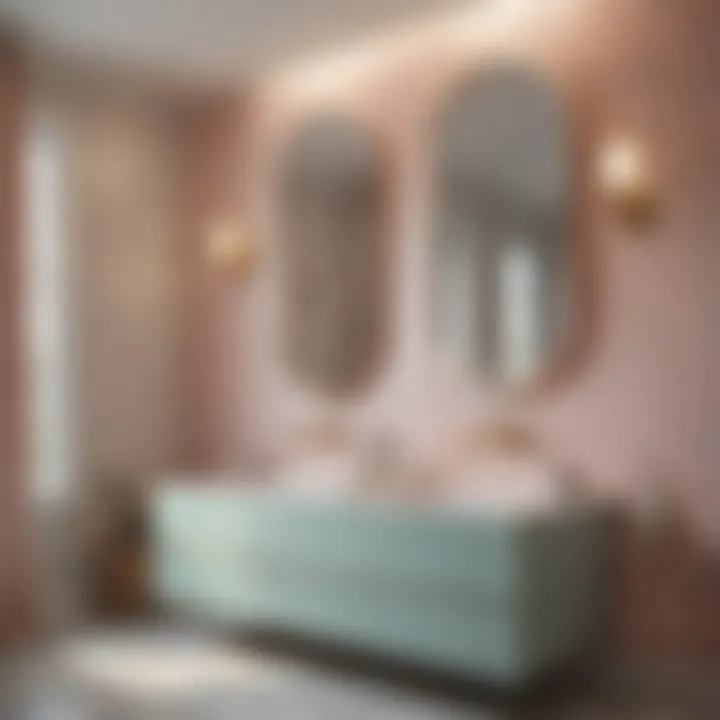
In closing, understanding these current trends in bathroom design enriches the decision-making process for homeowners. Each approach, whether minimalist, bold, or textured, presents unique opportunities for personal expression and functional improvement in bathroom spaces.
Choosing the Right Color Palette
Choosing the right color palette is a pivotal step in transforming any bathroom. Colors influence how a space feels and function in our daily lives. In a bathroom, where we spend time preparing for the day and winding down in the evenings, the right colors can significantly enhance our experience. A well-thought-out color scheme can create a serene oasis or a vibrant, invigorating space. Understanding the nuances of color can help you achieve the desired atmosphere in your bathroom while also complementing other design elements.
Understanding Color Psychology
Color psychology is the study of how colors affect mood and behavior. In bathrooms, colors play a crucial role. For instance, soft blues and greens are often associated with calmness and tranquility, perfect for creating a relaxing environment. These shades can evoke feelings of coolness and freshness. In contrast, warmer colors like yellows and reds can add energy and warmth, making the space feel cheerful and inviting. When selecting colors, consider the emotions you wish to evoke each time you step into the bathroom. Understanding these psychological principles can guide your choices significantly.
Popular Retro Color Schemes
Retro color schemes have made a noticeable comeback in bathroom design. Colors like mint green, pale pink, and deep burgundy harken back to mid-20th century styles. These colors not only express a sense of nostalgia but also bring uniqueness to the modern bathroom. Mint green, for instance, pairs beautifully with white accents, giving a fresh feel to the space. Pale pink can create a soft, romantic ambiance, suited for a relaxing atmosphere. Utilizing these hues can create a stunning visual effect while recalling the charm of past eras.
Creating Contrast and Harmony
Balancing contrast and harmony within your chosen color palette is essential for a visually appealing bathroom design. Contrast can come from complementing colors that enhance each other, such as dark countertops against light walls. This not only adds visual interest but also helps standout features shine. On the other hand, harmony refers to how colors within the palette work together to create a cohesive look. Utilizing shades from the same color family can achieve harmony. Experimenting with different tones and shades will allow you to curate a palette that's vibrant yet comfortable.
Important Consideration: Always test paint samples in the actual bathroom lighting before making a final decision. Different lighting can alter how colors appear, affecting the overall intended feel of the space.
Techniques for Painting Bathrooms
Understanding the techniques for painting bathrooms is essential for homeowners aiming to transform their spaces efficiently. Effective painting methods can significantly enhance the ambiance of a bathroom while ensuring durability. Knowledge of preparation, application, and finishing techniques allows for an improvement not just in appearance but also in functionality, making this aspect vital for any renovation project.
Preparation Steps
Preparation is the backbone of any successful painting project. It involves assessing the current condition of the walls and surface. Begin by cleaning the surfaces to remove any grime or mold, particularly in moisture-rich environments like bathrooms. Use a mild detergent mixed with water for this task. Next, ensure that surfaces are dry before proceeding.
It is equally important to repair any imperfections. Fill holes or cracks with a spackling compound and sand the area smooth once dried. Lastly, protect any fixtures or areas not meant to be painted by using painter's tape and drop cloths. Dedicating time to thorough preparation can lead to an impeccable finish.
Application Methods
There are three primary methods to apply paint effectively: brushing, rolling, and spraying. Each technique has its specific benefits and is suited for different situations in the bathroom.
Brushing
Brushing is a traditional technique that offers excellent control. It is ideal for corners, edges, and detailed areas of the bathroom. The key characteristic of brushing is precision, allowing painters to maneuver around fixtures seamlessly. This method is beneficial for textured surfaces or when fine detail is important. However, it can require more time and effort compared to other methods.
Using a high-quality brush can further enhance the result, ensuring smooth application and even coverage.
Rolling
Rolling is widely recognized for its efficiency in covering larger wall areas. This technique reduces application time and produces a uniform layer of paint. The main advantage of rolling is the speed at which it can be executed, making it a popular choice for many homeowners. It’s particularly effective on flat surfaces. However, rolling may fall short in reaching tight spaces, thus requiring a touch-up with a brush afterward.
Spraying
Spraying, while not as common for DIY projects, offers a seamless coat without the brush strokes or roller texture. This technique is advantageous for achieving a fine finish and is particularly useful in larger bathrooms where walls can be painted quickly. However, it demands a level of expertise and proper equipment. Overspray can become a concern, so caution is necessary to protect areas not intended for painting.
Finishing Touches
Once the paint is applied, the finishing touches play a crucial role in elevating the overall look of the bathroom. This stage includes removing painter's tape carefully to avoid any peeling. It is also wise to inspect for any drips or missed spots and address them promptly. Depending on the paint type, a second coat may be necessary for an even finish. Finally, reassess the space's harmony, ensuring that the paint complements the bathroom fixtures and accessories.
Selecting Appropriate Paint Types
Choosing the right paint for a bathroom is a crucial decision in the overall design transformation process. This step can significantly impact both the appearance and longevity of the painted surfaces. Factors such as durability, aesthetics, and maintenance requirements should all be considered before making a selection. An appropriate paint type will not only enhance the beauty of the bathroom but also offer practical benefits for everyday use.
Choosing Between Matte and Glossy Finishes
Finishes play a vital role in the final look of any painted surface. Matte finishes are often favored for their understated elegance. They can give walls a soft, muted look, which works well in serene and calming bathroom environments. However, matte surfaces tend to be less moisture-resistant, making them more susceptible to stains and easier to damage. This could lead to increased maintenance later.
On the other hand, glossy finishes reflect light, adding a sense of spaciousness. They are more durable and easier to wipe clean, making them a practical choice for high-humidity areas. Yet, the shine may demand more attention in terms of maintaining an immaculate surface. Ultimately, the choice between matte and glossy finishes should be aligned with both aesthetic goals and practical needs. It's helpful to visualize how each option could complement elements like tiles and fixtures.
Understanding Moisture Resistant Paints
In a bathroom, moisture levels can fluctuate dramatically. For this reason, using moisture resistant paints is essential. These paints are formulated specifically to withstand high humidity and resist mildew growth, ensuring that the paint job lasts longer without peeling or discoloration. Many brands, such as Benjamin Moore and Sherwin-Williams, offer specific lines of moisture-resistant paint tailored for bathroom use.
When selecting moisture resistant paints, look for products labeled as "bathroom paint" or "kitchen and bath paint." They often contain additives that provide enhanced protection against moisture.
In addition to choosing the right type of paint, applying it correctly also matters. Following precise application techniques can ensure that the paint adheres properly and performs efficiently in the face of steam and moisture.
"Selecting the appropriate paint type is not merely a cosmetic decision; it is a key aspect of preserving the integrity of the bathroom's environment."
Overall, understanding the importance of paint types in bathroom settings can steer homeowners and housekeepers towards a rewarding and visually appealing transformation.
Incorporating Patterns and Designs
Incorporating patterns and designs into bathroom painting not only enhances aesthetic appeal, but also helps to create a personalized space. Patterns can be a powerful tool in transforming a monotonous environment into something striking. They draw the eye and can serve as focal points within the room. However, success in using patterns lies in understanding the benefits as well as the considerations that come with them.
The importance of patterns lies in their ability to add depth and texture to walls. A simple painted wall can appear flat and uninspiring. In contrast, patterns can establish a visual rhythm, often making spaces more dynamic. Additionally, specific patterns can complement or contrast with existing fixtures, creating a harmonious or striking effect. Choosing the right design can meld seamlessly with the overall theme of the bathroom.
When considering patterns for a bathroom, factors such as space, light, and existing decor come into play. For smaller bathrooms, subtle patterns might work better, preventing the room from feeling too cramped. In larger spaces, bolder designs can add character without overwhelming the viewer. It is essential to visualize how different elements interact, especially when patterns might clash with other features.
Patterns can transform the mundane into the memorable. Balancing complexity and simplicity is key to success.
Stripes and Geometrics
Stripes and geometric patterns are distinctive choices when decorating bathrooms. They provide a modern look and can suit both traditional and contemporary themes.
Stripes can elongate or widen a room depending on direction. Horizontally applied stripes may create the illusion of width, making narrow spaces appear more expansive. Conversely, vertical stripes can elevate the sense of height, beneficial in low-ceilinged areas. Stripes come in various sizes and colors; thus, choosing the right scale is crucial for achieving the desired effect.
On the other hand, geometric patterns add a systematic aesthetic, perfect for those looking to introduce a sense of order to chaotic spaces. Hexagons, diamonds, and chevrons can create visual interest. They can be utilized in various ways—from a full wall covering to an accent stripe. The choice of color can reinforce the elegant structure of the pattern.
Stencils and Murals
Stencils and murals are another approach to incorporating pattern into bathroom designs. They bring a personalized touch, with stencils offering the flexibility of repeated patterns without the commitment of wallpaper. Stencils allow for precise designs that can fit any wall area while making it possible to choose colors aligned with the overall color scheme.
Murals can offer a stunning focal point, encouraging creativity. They might depict serene landscapes or abstract designs tailored to individual preferences. When used wisely, they can transform bathrooms into intimate retreats. However, proper placement is paramount. Murals should be positioned in a way that enhances the overall aesthetic without overwhelming the space.
Bathroom Lighting and Its Influence
Bathroom lighting plays a crucial role in both the functionality and aesthetic appeal of a space. Proper illumination affects how one perceives color and texture, making it an essential consideration in bathroom design. Selecting the right lighting can enhance the overall appearance of painted surfaces, ensuring that the colors used truly shine and contribute to a welcoming atmosphere. Poor lighting can lead to dullness, thereby detracting from even the most thoughtfully chosen color palettes.
Moreover, different types of lighting can create varying moods and enhance the utility of the bathroom. Tasks such as applying makeup or shaving require bright light, while softer lighting is advisable for relaxation. Balancing these lighting needs is vital for achieving an effective bathroom environment. Additionally, understanding how lighting influences color perception is critical in ensuring that the chosen hues align with the targeted ambiance.
Types of Bathroom Lighting
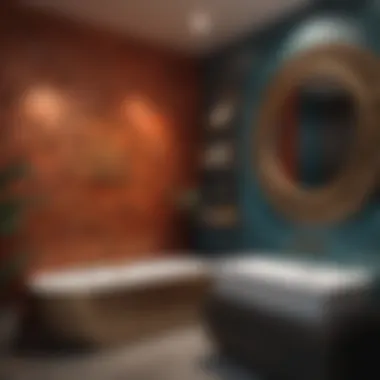
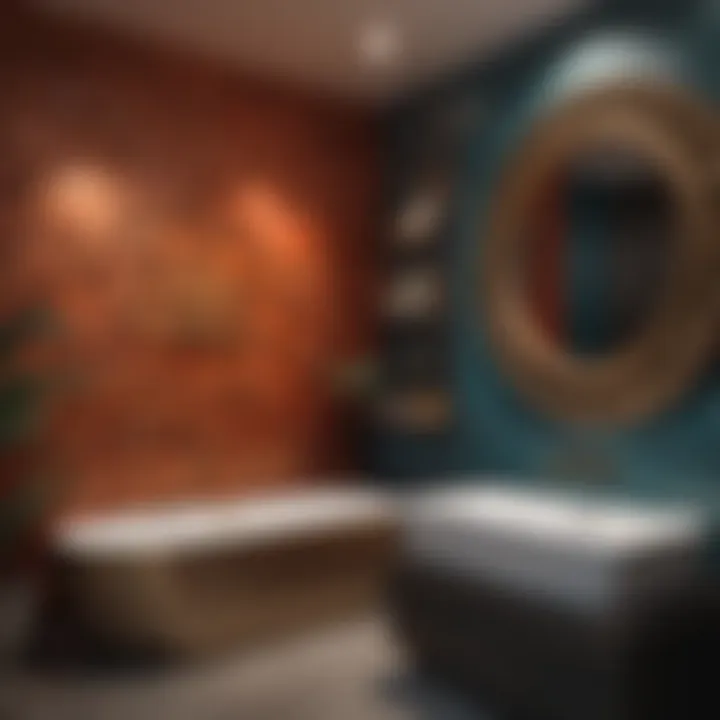
There are several types of lighting that can be incorporated into bathroom designs:
- Ambient Lighting: This provides overall illumination. Ceiling fixtures or recessed lights typically serve this purpose, allowing even light distribution.
- Task Lighting: This lighting is focused on specific areas, such as around mirrors. It helps in carrying out tasks that require more visibility, avoiding shadows.
- Accent Lighting: Used to highlight specific design features, accent lighting adds depth to the design. This can include wall sconces or under-cabinet lights.
By carefully choosing the type or combination of lighting, homeowners can significantly enhance their bathroom spaces.
Impact of Lighting on Color Perception
Lighting is a key factor which impacts how colors are perceived. Natural light, for instance, brings out the true essence of colors. In contrast, incandescent or fluorescent light can distort hues, making paint colors appear either warmer or cooler than intended. This mismatch can alter the overall mood of the room and disrupt the desired aesthetics.
It is beneficial to test paint colors under the intended lighting before making a final choice. A sample swatch on the wall will demonstrate how light interacts with the color at different times of the day. This practice ensures that the desired appearance is achieved once the bathroom is fully painted.
Important Note: Always consider the color temperature of the bulbs used. Warmer tones can make colors appear more vibrant, while cooler tones tend to mute them.
Maintaining Painted Surfaces
Maintaining painted surfaces in bathrooms is crucial for prolonging the life and appearance of the paint. Bathrooms experience high humidity and frequent cleaning, which can easily wear down not just the paint but also the wall's structural integrity. Regular and proper maintenance helps to keep the aesthetic appeal intact while ensuring the surfaces remain functional and safe, crucial for bathrooms that frequently face moisture exposure.
Cleaning Techniques
Cleaning painted surfaces should be approached with care to avoid damaging the finish. It is essential to use mild cleaning solutions and soft sponges or cloths. Here are some recommended techniques for cleaning:
- Use a gentle soap solution: Mix water with a few drops of mild dish soap. Avoid harsh or abrasive cleaners as they can strip the paint.
- Soft cloths or sponges: Utilize non-abrasive materials to prevent scratching the surface. Microfiber cloths are particularly effective.
- Damp cleaning: Wipe the surfaces gently with a damp cloth. Too much moisture can weaken the paint, so ensure to wring out excess water.
- Spot clean stains promptly: Addressing spills or stains as soon as they occur prevents them from becoming more difficult to remove later.
Touch-Up Strategies
Touch-ups are an important part of maintaining painted surfaces in bathrooms, as they allow for quick corrections without repainting the entire wall. Here are some effective strategies:
- Keep leftover paint: Store any extra paint from the original project. This helps ensure color consistency when doing touch-ups.
- Use a small brush: A small brush allows for precision, especially around fixtures or in corners. Avoid using larger brushes, which may apply too much paint.
- Feathering technique: When touching up, blend the new paint with the surrounding area using light strokes. This technique helps to minimize the appearance of patches.
- Regular checks: Regularly inspect painted surfaces for wear or damage. Early detection affords you the opportunity to perform touch-ups before issues become larger problems.
"Maintaining the integrity of painted surfaces can initially require diligence, but the long-term benefits of aesthetic continuity and cost-saving measures are invaluable."
By implementing consistent cleaning techniques and strategic touch-ups, homeowners can preserve the beauty of their bathroom paint, ultimately enhancing the space's overall ambiance.
Common Mistakes in Bathroom Painting
Painting a bathroom involves more than just applying a new coat of color. It is an art that requires careful planning and attention to detail. This section discusses common mistakes that homeowners often make when undertaking the painting process. By understanding these pitfalls, one can ensure a more successful transformation of the bathroom space, ultimately enhancing both its beauty and functionality.
Ignoring Surface Preparation
One of the most critical steps in bathroom painting is surface preparation. Ignoring this step can lead to various issues like peeling paint or uneven finishes. Before applying paint, it is essential to clean the walls thoroughly to remove dust, soap scum, or mildew. This ensures that the paint adheres properly to the surface. Treating any areas of mold or mildew with an appropriate cleaner is also fundamental. Otherwise, these contaminants can show through, damaging the aesthetic and healthiness of the environment.
Additionally, sanding the surfaces can help to create a smooth base, especially if the previous paint layer is glossy. Skipping this can result in a poor finish and reduced longevity of the paint job. Furthermore, using a primer can be an excellent way to ensure that the color applied is true to its initial shade and offers better durability.
Choosing Inappropriate Colors
Selecting the right color for a bathroom is vital for creating the desired ambiance. Choosing inappropriate colors can make the space feel cramped, cold, or uninviting. For instance, very dark colors can make small bathrooms look even smaller. Conversely, overly bright colors might overwhelm the senses, leaving the space feeling chaotic.
Before settling on a color, it helps to consider the bathroom's size, lighting, and existing fixtures. Soft neutrals often provide a relaxing environment and pair well with various accessories and finishes. Test several color swatches on the walls to see how they look at different times of the day; lighting can dramatically alter the perception of color.
It is easier to prefer simplicity and elegance in a bathroom to avoid feelings of chaos and discomfort in the space.
DIY vs. Professional Painting
When it comes to transforming your bathroom through painting, a significant decision arises between taking the DIY route or hiring professionals. Each approach has its unique merits and challenges. It is essential to consider various elements before making this choice.
Pros and Cons of DIY
Engaging in do-it-yourself painting can be appealing for several reasons.
Pros:
- Cost Savings: One of the most attractive aspects of DIY is financial savings. You avoid labor costs associated with hiring professionals.
- Personal Satisfaction: Completing the project yourself can yield a sense of accomplishment. It allows you to personalize every detail.
- Flexibility in Scheduling: DIY allows you to work at your own pace. There are no constraints tied to a contractor's schedule.
Cons:
- Time-Consuming: Painting requires significant preparation and execution time. This process may take longer than anticipated, especially if you have a busy schedule.
- Skill Level: Your painting skills can greatly affect the outcome. If you lack experience, it might lead to unsatisfactory results.
- Inconsistent Finish: Achieving a professional-looking finish can be difficult without proper techniques and tools.
When to Hire Professionals
Hiring a professional painter can also be a viable option for many homeowners.
Considerations for Hiring Professionals:
- Expertise and Experience: Professional painters possess the training and know-how to handle various painting challenges. Their experience ensures a smoother process and superior results.
- Efficient Project Completion: Professionals can often complete painting projects in a fraction of the time compared to DIY, due to their experience and resources.
- Quality Assurance: When paying for a professional service, there's an expectation of quality. This reliability can provide peace of mind, knowing your bathroom will be transformed correctly.
- Complex Projects: If your bathroom has intricate designs or tricky angles, a professional can manage these complexities with ease.
Sustainable Painting Practices
Sustainable painting practices are increasingly becoming important in home renovations, particularly in spaces like bathrooms where moisture and prolonged usage affect the longevity of painted surfaces. These practices focus on utilizing resources that minimize the environmental impact while promoting a healthier living environment. Eco-conscious choices do not only pertain to the paint itself but also extend to the techniques and tools used during the painting process. Prioritizing sustainability in bathroom painting illustrates a commitment to both aesthetics and eco-friendliness, which can enhance the overall appeal of the space.
Eco-Friendly Paint Options
When considering eco-friendly paint options, the first aspect to look at is the content of the paint. Low-VOC (Volatile Organic Compounds) and no-VOC paints are ideal for bathroom spaces. These types of paints release fewer harmful emissions into the air compared to traditional paints. Moreover, they tend to have a more pleasant odor, making the painting process more comfortable. Brands such as Benjamin Moore Aura and Sherwin-Williams Harmony offer reliable eco-friendly choices suitable for high moisture environments.
In addition to VOC levels, you can also select paints containing natural pigments and fewer synthetic additives. For example, natural paint brands like Earthborn utilize clay and minerals, leading to a safer indoor air quality. Always check the paint label to understand its ingredient composition.
Waste Reduction Tips
Reducing waste during the painting process is essential for sustainable practices. Here are a few effective methods to minimize waste:
- Plan Before You Paint: Carefully measure the surfaces to avoid purchasing more paint than necessary.
- Proper Storage: Store leftover paint in airtight containers. Label these containers with the date and type of paint for future use.
- Recycle: Many local centers accept used paint for recycling. Furthermore, old brushes and rollers can be cleaned and reused or repurposed.
- Avoid Single-Use Items: Opt for reusable drop cloths and rollers instead of disposable ones. This minimizes landfill contributions and promotes reuse.
By following these waste reduction strategies, homeowners can significantly reduce their environmental footprint while maintaining stylish and functional bathroom spaces.
By integrating eco-friendly options and waste reduction practices, homeowners can create inviting bathrooms that are not only beautiful but also sustainable, aligning with a modern ethos of environmental responsibility.
Scalability of Bathroom Paint Projects
When considering bathroom painting projects, scalability is a crucial factor. It determines how extensive the renovation can be, whether it’s a small touch-up or a full transformation. Understanding the scalability of these projects allows homeowners to make informed decisions based on their individual budgets, space constraints, and desired outcomes.
One main benefit of scalable painting projects is flexibility. Homeowners can begin with small updates that fit their budget and progressively undertake larger modifications as resources allow. This incremental approach not only eases financial strain but also minimizes disruption in the household. Additionally, it allows for testing different styles and colors without committing to a total overhaul at once.
Another aspect to consider is the time involved. Smaller projects can usually be completed quickly, maintaining the functionality of the space. Yet, as the project scales up, planning becomes essential. Homeowners need to think about the sequences of tasks, the availability of materials, and how to maintain an organized workflow to avoid chaos.
This scalability not only applies to size but also to the complexity of painting techniques. For instance, simple color changes may require less time and expertise compared to intricate patterns or textures. Understanding what is feasible within your current resources can result in successful outcomes without overextending capabilities.
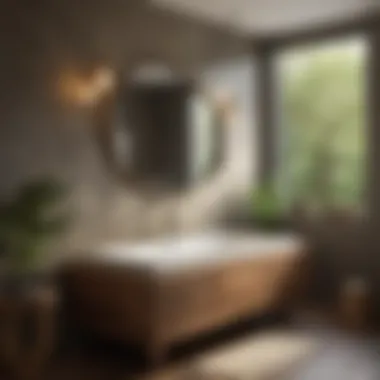
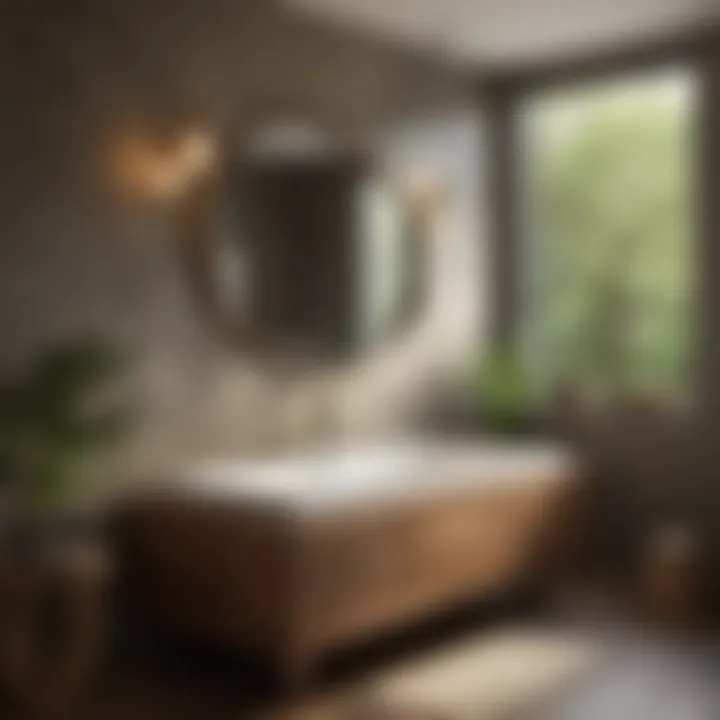
"Scalability allows for a personalized approach, letting homeowners prioritize what matters the most in their renovation journey."
Budget-Friendly Approaches
The concept of budget-friendly approaches offers a significant advantage for scaling bathroom paint projects. Homeowners can utilize various strategies to maintain costs while achieving stunning results. One effective method is to select cost-efficient, high-quality paint that offers durability without breaking the bank. Brands such as Behr and Sherwin-Williams provide great options for consumers conscious of their spending.
Another approach is to focus on accent walls. Rather than painting the entire bathroom, applying a fresh coat of paint to one wall creates visual interest and reduces material costs. Furthermore, maximizing natural light can influence the paint colors chosen. Lighter hues can make a space appear larger and brighter, allowing for a high-impact design with less paint.
Additionally, focusing on painting techniques that require less precision, such as sponging or rag rolling, can help navigate around high costs typically associated with labor. These techniques can create beautiful textural effects while minimizing the need for professional help.
Creating Impact with Minimal Investment
Creating impactful designs on a minimal budget is entirely possible within the context of bathroom painting projects. Color choice plays a vital role in this scenario. Utilizing bold, rich colors can energize the space, while soft pastels can induce calmness, allowing for a specific atmosphere to be cultivated with just a pint of paint.
Furthermore, innovative patterns such as geometric shapes can capture attention without requiring extensive materials. Applying painter's tape to compose various shapes provides a modern aesthetic and an engaging focal point. This approach is not only affordable but also enables homeowners to personalize their spaces with little financial commitment.
Finally, accessorizing after painting can enhance the overall look. Simple items like mirrors, wall artwork, and decorative towels can integrate seamlessly into painted walls. The resulting design will feel complete and visually appealing, achieving the illusion of a more significant investment without the high costs associated with a complete makeover.
Inspiration from Global Designs
Exploring innovative bathroom painting designs requires looking beyond borders. Global inspiration can transform a mundane bathing space into a work of art. Each culture brings its own unique perspective, and understanding these influences enhances creativity and personalization in design.
Cultural elements play a significant role in color selection. Different regions have distinctive palettes influenced by nature, architecture, and traditions. For instance, Mediterranean designs frequently feature vibrant blues and sandy neutrals, reflecting coastal landscapes. On the other hand, Japanese aesthetics might lean towards subtle tones, emphasizing tranquility and simplicity. Integrating these ideas can add depth and richness to bathroom spaces.
A more diverse approach not only enriches the overall look but also allows the homeowner to express cultural narratives or personal stories. Consideration should be given to the emotional language of colors. Associating shades with feelings can create atmospheres that enhance relaxation or energize daily routines.
Cultural Influences on Color Use
Colors are far more than mere aesthetics; they hold significant meaning across cultures. For instance, in India, red is often associated with auspiciousness and prosperity, while in Western contexts, it can signify passion and energy. Understanding these cultural meanings can make a difference when choosing colors for your bathroom.
Some colors are universally appreciated for their calming effects. Blue and green tones are favored in various cultures for their connection to nature, tying back to water and foliage. These colors work well in bathrooms, offering a soothing retreat.
"Color is the keyboard, the eye is the harmonium, the soul is the piano with many strings."
—Wassily Kandinsky
Analyzing Regional Aesthetics
Regional architecture and local materials shape how color is perceived and used in bathroom designs. For example, Scandinavian countries prioritize minimalism and functionality, utilizing whites and cool tones that reflect natural light. This aesthetic can make a small bathroom appear more spacious and inviting.
In contrast, Latin American styles are known for bold colors and intricate tilework. Incorporating rich hues of terracotta or azulejos can evoke a sense of warmth and vibrancy.
It’s essential to consider local environment factors as well. Coastal areas might inspire softer pastels, while urban environments could lean toward darker, more sophisticated tones. Analyzing these aesthetics not only helps in selecting a suitable palette but also ensures that the bathroom harmonizes with its surroundings.
In summary, drawing inspiration from global designs can significantly enhance bathroom aesthetics. By acknowledging cultural influences and analyzing regional aesthetics, homeowners can create bathrooms that are not just functional spaces, but reflections of personal and cultural identities.
Aligning Painting Choices with Bathroom Fixtures
When considering innovative bathroom painting designs, aligning painting choices with bathroom fixtures is a crucial element. Fixtures such as faucets, towel bars, and light fixtures not only serve functional purposes but also significantly contribute to the overall aesthetic of the space. Achieving a cohesive look where paint colors and fixture designs complement each other can elevate the bathroom’s visual appeal.
Color goes beyond the paint on the walls. It communicates a style and mood that can either harmonize or clash with fixtures. For example, a sleek, modern faucet may appear out of place against vibrant, rustic wall colors. Therefore, it is imperative to analyze the existing bathroom fixtures and choose paint colors that enhance and harmonize with those features. This alignment can lead to an inviting and polished atmosphere that feels balanced.
Harmonizing Colors with Hardware
To effectively harmonize colors with hardware, start by identifying the finish of the fixtures. Common finishes include chrome, brushed nickel, bronze, and matte black. Each of these has distinct characteristics and impacts the color selection for paint.
- Chrome finishes often work well with cool colors such as light blues, greys, or whites, creating a sleek modern vibe.
- Brushed nickel can adapt to a range of colors but is particularly compatible with soft pastels.
- Bronze finishes bring warmth and richness, complementing earthy tones or jewel colors like deep green or sapphire.
- Matte black pairs elegantly with light colors and can add drama when used against bright or pastel shades.
It is also helpful to consider how light interacts with the chosen colors and finishes. Use natural light and artificial lighting to evaluate how colors will look at different times of the day and under different conditions.
Incorporating Accessories for Cohesion
Incorporating accessories is another substantial approach to ensuring cohesion in bathroom design. Accessories such as towels, shower curtains, and decorative elements should echo the chosen color scheme established by wall paint and fixture finishes. Thoughtfully selected accessories can tie the entire look together, creating a harmonious atmosphere.
When selecting accessories:
- Choose towels that are in either a complimentary or contrasting shade to the wall color. Soft, muted colors often create a serene environment, while brighter towels can add a fun pop.
- Use shower curtains that reflect the overall palette. For example, a patterned curtain can introduce various shades, bridging colors between the paint and hardware.
- Wall art or decorative pieces can bring together colors and finishes in creative combinations, enhancing the thematic coherence.
By aligning painting choices with bathroom fixtures and strategically incorporating accessories, one can transform a basic bathroom into a thoughtfully curated space. Each decision adds depth to the overall design while ensuring functionality and aesthetics work in tandem.
The Role of Texture in Bathroom Aesthetics
Texture plays a pivotal role in transforming the overall aesthetic of a bathroom. It can add dimension, depth, and a unique character to what might otherwise be a plain space. Many homeowners prioritize aesthetics when it comes to bathroom renovations and painting. An understanding of how texture influences appearance can be key to making informed design decisions. It helps achieve a layered look, where colors and textures communicate and enhance each other.
Incorporating various textures can lead to benefits such as increased visual interest and the impression of spaciousness. These elements are particularly important in a bathroom, often one of the smaller spaces in a home. When properly utilized, texture can create a soothing oasis or a vibrant retreat, depending on personal taste.
Considerations about texture go beyond merely aesthetics. They can also impact maintenance and functionality. Textured finishes can hide imperfections in walls and surfaces, making them a practical choice in a bathroom that may be subject to wear and moisture. Additionally, some textured paints are designed to be more resilient against humidity, ensuring longevity in a moisture-rich environment.
"Understanding texture allows for a more innovative approach to design. It’s not just about the color; it’s about how the surfaces feel and interact with light."
Creating Depth with Textured Paints
Using textured paints is an effective way to add depth to a bathroom's design. Textured paints come in various finishes, from rough to smooth, and can be applied to walls to create a layered effect. This method allows for a richer visual experience. When light hits these surfaces, it creates shadows and highlights, enhancing the room's appeal.
There are several types of textured paints. For instance, some are designed to mimic natural materials such as stone or plaster, providing an organic feel. Others offer a more modern twist with geometric patterns. Selecting the right textured paint can revolutionize the bathroom, making it feel both inviting and stylish. Homeowners should also consider colors that complement the texture to achieve the desired impact.
Softening Spaces with Textiles
Textiles play a significant role in softening the hard surfaces often found in bathrooms. Towels, rugs, and curtains can introduce warmth to the space. They create a contrast to the often cold materials like tiles and metals commonly used. Carefully chosen textiles not only provide comfort but also allow for additional color and pattern, enhancing the overall design strategy.
When incorporating textiles, consider color palettes that harmonize with painted surfaces. Soft fabrics can balance out textured paints, creating a cohesive look. For instance, neutral colors in textiles can soften the bold hues on the walls, while patterned textiles can complement or contrast with textures effectively. These elements work together to create a serene atmosphere in the bathroom.
Adding textiles introduces another layer of dimension. Regular maintenance and cleaning are vital for keeping these materials looking fresh and vibrant. Designers can consult resources for recommendations on textile care, particularly in humid environments. This ensures the aesthetic remains intact over time.
Final Thoughts on Bathroom Painting Designs
In the realm of interior design, bathroom painting plays a pivotal role in shaping both the aesthetic appeal and functionality of this essential space. When considering the transformative potential of innovative bathroom painting designs, it is crucial to recognize a few key aspects that can significantly enhance any bathroom. This section consolidates these thoughts, providing readers with a final perspective on the nuances of bathroom painting.
Review of Key Considerations
When embarking on a bathroom painting project, several critical factors must be kept in mind:
- Durability of Materials: The bathroom is a moisture-rich environment. Thus, selecting paint that can withstand splashes, humidity, and steam is vital. Opting for moisture-resistant paints not only preserves the finish but also extends the life of the colors chosen.
- Color and Lighting: The chosen color palette should harmonize with the natural and artificial lighting present in the bathroom. Lighter shades can make small spaces feel larger, while darker tones may create an intimate ambiance. Understanding how light interacts with colors is essential for achieving the desired atmosphere.
- Texture Considerations: Certain textured finishes can provide depth and interest, adding layers to the overall design. These can be particularly effective in smaller bathrooms where every detail counts.
"The right paint can make a small bathroom feel more spacious or a large bathroom feel more cozy."
- Personal Style Alignment: Finally, it's essential to ensure that the painting design resonates with individual tastes and complements existing fixtures or decor. This personal touch turns the bathroom from merely functional to truly inviting.
Looking Ahead: Future Trends
As the world of interior design evolves, several emerging trends signal the future direction of bathroom painting designs:
- Sustainable Practices: There is a growing emphasis on eco-friendly paints that are low in volatile organic compounds (VOCs). This trend not only benefits the environment but also contributes to healthier indoor air quality.
- Bold and Unique Patterns: Homeowners are increasingly embracing daring patterns and unconventional colors. Whether it’s through large-scale geometric designs or playful color combinations, these choices allow for personalization and creativity.
- Smart Technology Integration: As technology continues to influence design, smart paints that can change colors with mood lighting are becoming more mainstream. This innovation adds a dynamic element to bathroom spaces.
- Cultural Influences: Global inspiration for color schemes, such as Mediterranean blues or tropical greens, reflects a richer palette that is both contemporary and diverse.
In summary, innovative bathroom painting designs combine artistry, functionality, and personal flair. As homeowners thoughtfully consider their choices, they are not only enhancing their immediate environment but are also engaging with greater design narratives that reflect both personal identity and broader trends. Understanding these elements will lead to informed decisions, ultimately transforming simple bathroom spaces into personalized retreats.















